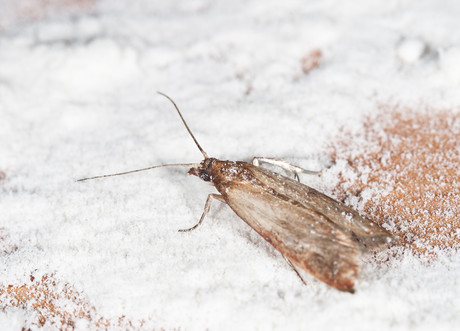Confused beetles and sex pheromones

Some stored product pests can lay 500 eggs in a week and live three years — controlling them is crucial.
Stored product pests (SPPs) are rarely associated with foodborne diseases but they affect the reputation and profits of food manufacturers through recalls, waste and returns. Though small, typically around 4 mm, these pests threaten our food supply at all stages of food processing: from whole kernels in grain silos and processed grains in a flour mill to food production, storage and distribution to homes and restaurants.
Know your pests
There are four main types of SPPs:
- Internal feeders
- Scavengers
- Secondary feeders
- External feeders
Internal feeders like rice weevils, lesser grain borers and almond moths feed on whole kernels or beans or pasta, while external feeders will eat just about anything. Scavengers such as the confused flour beetle prefer broken or processed grain, nuts or cocoa. Mouldy grain is the preferred diet of secondary feeders. With such an extended range of SPPs and all their different preferred diets it is essential that you identify any pests so you can isolate the source and put remedial actions into place.
Inspection and monitoring is crucial
Female Confused Flour Beetles (Tribolium Confusum) can live for up to three years, and are tolerant of cold and very low humidity. In their preferred conditions, 30–32°C and 70% relative humidity and lots of food, the population of Confused Flour Beetles can increase 60-fold in under a month. You really can’t afford to let these pests get a hold in your facility.
All incoming raw materials should be inspected in an area away from the main storage area for any evidence of live pest activity. If found the material should be immediately rejected and returned to the supplier.
Fit monitoring devices like stored pest insect pheromone pots and glue trap lures throughout your facility so you can discover localised infestations, determine the severity and type of species of an infestation and monitor the effectiveness of treatments.
Install light traps in all internal areas of the premises to control and monitor flying insects. Commercial traps which use ultraviolet light to attract some but not all stored product pests are available. For added efficacy add pheromone lures to the light traps.
Pheromone traps
Pheromones are species-specific semiochemicals that insects, even non-SPPs, use to communicate. The message relayed by that pheromone varies depending on which pheromone the sender uses. Synthetic versions of the pheromones can be placed in traps to draw adult SPPs out of their harbourage. To assist in monitoring, we have two types of pheromone available for use, sex pheromones and aggregate pheromones.
Sex pheromones
Typically released by a female and detected by males, sex pheromones let those who detect them know that the sender is ready to mate. Sex pheromones are strongly attractive and typically associated with those adult SPPs that have short adult life spans: they need to ensure they find a mate before they die. A sex pheromone helps the male and female find each other. They are very effective as a monitoring pheromone because the need to mate will typically trump the need to eat or hide, drawing more responses. However, only the male will respond.
Aggregate pheromones
Aggregate pheromones may be released by either males or females, depending on the species, but both males and females can detect them, unlike with sex pheromones which are sex-dependent. These pheromones are saying “come here” because of a food or shelter source. Unfortunately, aggregate pheromones tend to be less effective than sex pheromones because SPPs are typically in the food they live in, so will not leave to respond to a pheromone that’s saying “I found food/ shelter”. Unfortunately, only a handful of SPP species have pheromones that are commercially available for monitoring.
The pheromone lure, whether sex or aggregate, is placed in a trap that catches the SPP. Most SPP pheromone traps are either tent (or diamond) traps or pit-fall traps. Tent traps are glueboards that hang in a tent or diamond shape. The pheromone is placed inside the trap, catching any members of the species that respond to the pheromone. Because they hang, these traps are designed to catch SPPs that fly.
Pit-fall traps are floor traps that have the pheromone inside, a cover to protect the pheromone and any insects caught, and a small space in between where crawling SPPs can climb through. Once they climb into the trap they fall into a pit and are unable to crawl out. These traps are often used in conjunction with a kairomone oil, which helps to keep the captured SPPs in the trap. These traps typically have a shorter lifespan than tent traps as they are primarily placed on the floor and often moved or lost as areas are cleaned or destroyed when placed in forklift traffic.
The traps reveal what SPPs are around, and if the traps are placed in a grid across the premises they can localise where the SPPs are hanging out but they are not in themselves a control measure.
For control and to meet HACCP requirements, nothing will beat the help and advice of professional pest eradicators.
Premium snack maker meets growing demand
UK chip manufacturer Burts has greatly increased its production capacity, enabled by TNA's...
Heat exchangers expand ginger beer production
Bundaberg Brewed Drinks ensured the equipment in its new Master Brewery maintained product...
In-house ginger processing for beverage maker
A ginger beer manufacturer reduces its supply risk by investing in pack-house technology to...














